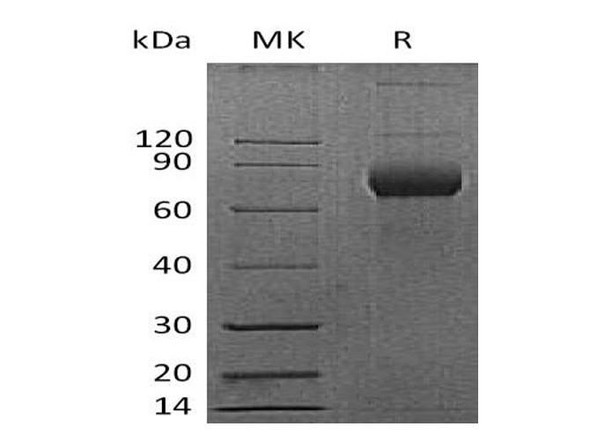Description
| Product Name: | Mouse gAcrp30 Recombinant Protein |
| Product Code: | RPPB0026 |
| Size: | 50µg |
| Species: | Mouse |
| Target: | gAcrp30 |
| Synonyms: | Acrp30, AdipoQ, GBP-28, APM-1, ACDC. |
| Source: | Escherichia Coli |
| Physical Appearance: | Sterile filtered colorless solution. |
| Formulation: | Acrp30 Mouse (1mg/ml) solution containing 20mM Tris-HCl pH7.5, 50mM NaCl, 5mM DTT and 10% Glycerol. |
| Stability: | Store at 4°C if entire vial will be used within 2-4 weeks. Store, frozen at -20°C for longer periods of time. For long term storage it is recommended to add a carrier protein (0.1% HSA or BSA).Avoid multiple freeze-thaw cycles. |
| Purity: | Greater than 95.0% as determined by SDS-PAGE. |
| Amino Acid Sequence: | MAYMYRSAFS VGLETRVTVP NVPIRFTKIF YNQQNHYDGS TGKFYCNIPG LYYFSYHITVYMKDVKVSLF KKDKAVLFTY DQYQEKNVDQ ASGSVLLHLE VGDQVWLQVY GDGDHNGLYADNVNDSTFTG FLLYHDTN |
Adiponectin (247amino acids) is adipocyte complement-related protein of 30 kDa and exclusively expressed in differentiated adipocytes. APM-1 (Acrp30 Mouse) is a member of the complement factor C1q family and consists of signal sequence, Non-homologous sequence, collagen domain and domain (gAcrp30). Adiponectin expression is reduced in a variety of obese and insulin-resistant states in human, monkeys and mice. Injection of Acrp30 Mouse (247aa) or gAcrp30 (globular domain) lowers serum glucose and free fatty acid level in mice.
The globular domain of Adiponectin Mouse Recombinant / Acrp30 Mouse contains 138 amino acid residues from a.a. 111-247 having molecular mass of 16 kDa was over expressed in E.coli and purified by using conventional chromatography techniques.
| UniProt Protein Function: | adiponectin: Important adipokine involved in the control of fat metabolism and insulin sensitivity, with direct anti-diabetic, anti-atherogenic and anti-inflammatory activities. Stimulates AMPK phosphorylation and activation in the liver and the skeletal muscle, enhancing glucose utilization and fatty-acid combustion. Antagonizes TNF-alpha by negatively regulating its expression in various tissues such as liver and macrophages, and also by counteracting its effects. Inhibits endothelial NF-kappa-B signaling through a cAMP-dependent pathway. May play a role in cell growth, angiogenesis and tissue remodeling by binding and sequestering various growth factors with distinct binding affinities, depending on the type of complex, LMW, MMW or HMW. Homomultimer. Forms trimers, hexamers and 12- to 18-mers. The trimers (low molecular weight complexes / LMW) are assembled via non-covalent interactions of the collagen-like domains in a triple helix and hydrophobic interactions within the globular C1q domain. Several trimers can associate to form disulfide-linked hexamers (middle molecular weight complexes / MMW) and larger complexes (higher molecular weight / HMW). The HMW-complex assembly may rely aditionally on lysine hydroxylation and glycosylation. LMW, MMW and HMW complexes bind to HBEGF, MMW and HMW complexes bind to PDGFB, and HMW complex binds to FGF2. Interacts with CTRP9A via the C1q domain (heterotrimeric complex). Synthesized exclusively by adipocytes and secreted into plasma. |
| UniProt Protein Details: | Protein type:Secreted, signal peptide; Endoplasmic reticulum; Hormone; Secreted Cellular Component: extracellular space; cell surface; collagen; protein complex; endoplasmic reticulum; extracellular region Molecular Function:identical protein binding; protein binding; protein homodimerization activity; hormone activity; sialic acid binding; receptor binding Biological Process: negative regulation of MAP kinase activity; negative regulation of phagocytosis; negative regulation of smooth muscle cell proliferation; negative regulation of hormone secretion; positive regulation of cellular protein metabolic process; membrane hyperpolarization; negative regulation of smooth muscle cell migration; glucose homeostasis; negative regulation of granulocyte differentiation; positive regulation of interleukin-8 production; positive regulation of glucose import; negative regulation of gluconeogenesis; response to glucose stimulus; adiponectin-mediated signaling pathway; negative regulation of protein amino acid autophosphorylation; negative regulation of blood pressure; negative regulation of cell migration; protein homooligomerization; positive regulation of I-kappaB kinase/NF-kappaB cascade; negative regulation of heterotypic cell-cell adhesion; positive regulation of signal transduction; glucose metabolic process; negative regulation of tumor necrosis factor production; negative regulation of I-kappaB kinase/NF-kappaB cascade; negative regulation of fat cell differentiation; negative regulation of synaptic transmission; membrane depolarization; positive regulation of peptidyl-tyrosine phosphorylation; positive regulation of fatty acid metabolic process; fatty acid beta-oxidation; negative regulation of macrophage differentiation; cellular response to insulin stimulus; negative regulation of low-density lipoprotein receptor biosynthetic process; positive regulation of protein kinase activity; negative regulation of inflammatory response; brown fat cell differentiation; fatty acid oxidation; positive regulation of protein amino acid phosphorylation; negative regulation of transcription, DNA-dependent; positive regulation of myeloid cell apoptosis; positive regulation of blood pressure |
| UniProt Code: | Q60994 |
| NCBI GenInfo Identifier: | 408359957 |
| NCBI Gene ID: | 11450 |
| NCBI Accession: | Q60994.2 |
| UniProt Secondary Accession: | Q60994,Q62400, Q6GTX4, Q9DC68, |
| UniProt Related Accession: | Q60994 |
| Molecular Weight: | 26,809 Da |
| NCBI Full Name: | Adiponectin |
| NCBI Synonym Full Names: | adiponectin, C1Q and collagen domain containing |
| NCBI Official Symbol: | Adipoq�� |
| NCBI Official Synonym Symbols: | APN; Acdc; apM1; 30kDa; GBP28; adipo; Acrp30�� |
| NCBI Protein Information: | adiponectin; adipocyte-specific protein AdipoQ; adipocyte complement related protein; 30 kDa adipocyte complement-related protein; adipocyte complement-related 30 kDa protein; adipocyte, C1Q and collagen domain containing; adipocyte, C1q and collagen domain-containing protein |
| UniProt Protein Name: | Adiponectin |
| UniProt Synonym Protein Names: | 30 kDa adipocyte complement-related protein; Adipocyte complement-related 30 kDa protein; ACRP30; Adipocyte, C1q and collagen domain-containing protein; Adipocyte-specific protein AdipoQ |
| Protein Family: | Adiponectin |
| UniProt Gene Name: | Adipoq�� |
| UniProt Entry Name: | ADIPO_MOUSE |










